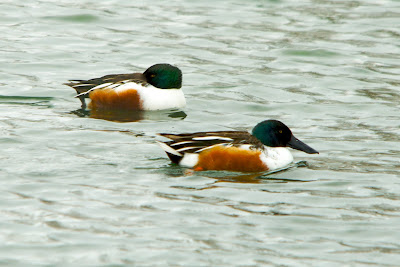
Northern Shovelers, Castalia, Ohio
It’s not uncommon at this time of year for birders to take a look at their life list and contemplate adding one more bird, or maybe chasing after a rare sighting in the area to sort of pump up the yearly species total. This past week I found myself guilty on both counts. The end result can be both good and less than good.
First, I thought Santa was going to deliver an early Christmas present to me. A few days before the holiday word popped up on the Ohio Ornithological Society’s hot line that several Ross’s Geese were at Castalia Pond, about 75 miles away, along with several Cackling Geese. The alarm bells sounded in our household and it wasn’t the jingling of sleigh bells. While both Susan and I have tallied the Ross’s Goose, the Cackling variety of Canada Goose has eluded us.
Plans were made, snacks packed, car gassed up and off we went. Oh, we did have company for the holidays, my brother in from the nation’s capital. He had heard of this bird-chasing habit of ours but had never witnessed it. I might add that he hates cold weather and the day’s temperature was 18—not a good combination.

American Wigeon, Castalia, Ohio
The end of the story is that it turned out to be a wild goose chase. The “target” birds were nowhere to be seen. My brother could not understand why we were not dismayed at driving all that distance and not seeing the bird. I tried to explain it’s an acquired skill, missing the target but hitting something else, like stunning Northern Shovelers and American Wigeons.
Then, on New Year’s Eve day, we had a repeat performance, sort of. This time it was a Golden Eagle reported at Mosquito Creek Wildlife Area, about 75 miles in the opposite direction. Again, we’ve both tallied the golden, but it’s so rare in Ohio, you just have to chase it—if at all possible. Our first in Ohio, several years ago, was on a day when the thermometer never got above minus 13. Now, that’s chilly—but worth it.
Again, to shorten the story, the beautiful Golden Eagle was not to be seen. In its place we tallied six Bald Eagles, an equally rare sight in Ohio.
All of which goes to prove, sometimes you win and sometimes you win in the birding game—true sport has no losers.

Bald Eagle, Mosquito Creek Wildlife Area















































